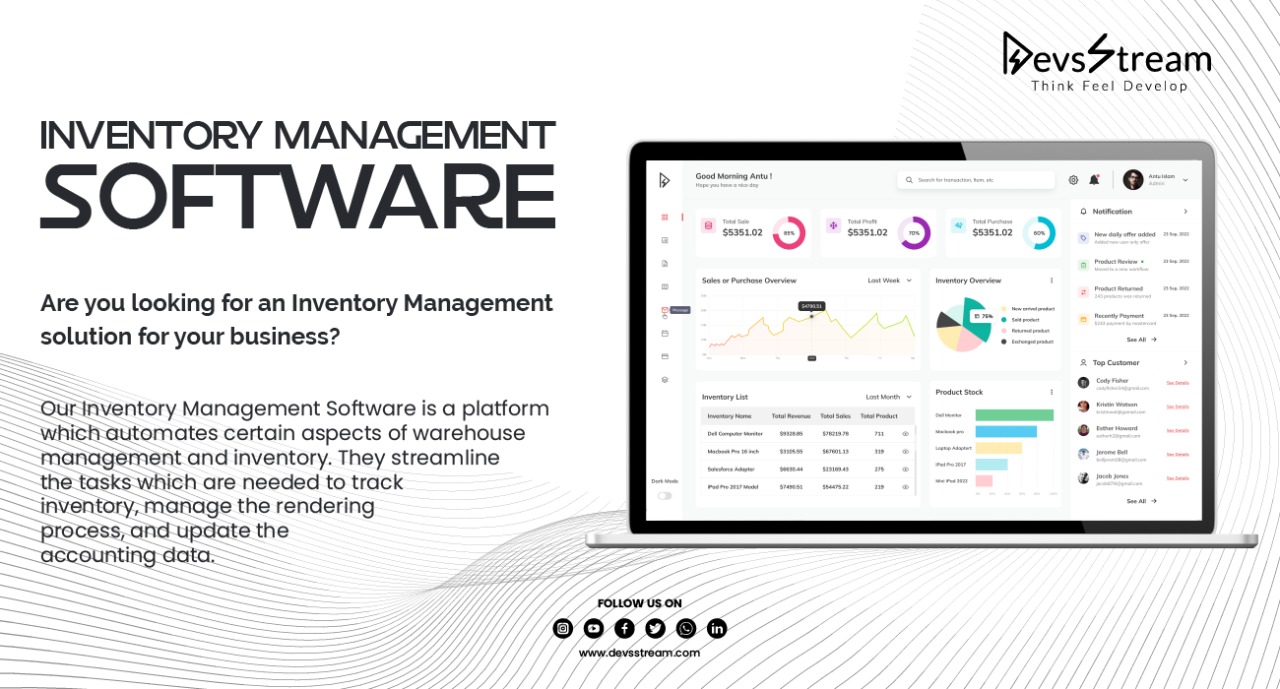
Inventory Management System
Inventory management software is a software system for tracking inventory levels, orders, sales, and deliveries It can also be used in the manufacturing industry to create a work order, bill of materials, and other production-related documents. Companies use inventory management software to avoid product overstock and outages. It is a tool for organizing inventory data that before was generally stored in hard-copy form or spreadsheets. Inventory management is key for any business that maintains a stock of goods or raw materials on hand. While inventory management was historically a manual process, modern technology has eliminated the need for a labor-intensive and error-prone manual inventory management system. Today, inventory management software is available to streamline the process, reduce errors and help businesses optimize the way they maintain and order the products they sell.
Inventory Management System: features for user
- Point Of Sale Integration: An integration with you point of sale system helps retailers automatically track when a product sells, whether in a physical storefront, on an e-commerce platform, or through another sales channel. When a product is scanned or checked out in an online cart, the point of sale system automatically updates the inventory management system, accounting for the sale in real-time. Coupled with automated reordering, this feature allows retailers to ensure they always have a suitable amount of stock to quickly fulfill orders.
- Inventory Catalog: For retailers, it is important to be able to catalog inventory not just by the type of unit, but also by distinguishing characteristics like size, color, and other distinguishing characteristics. For example, if you sell shoes, you should be able to specify shoes down to the specific type – your system should identify if you have a quantity of 10 sizes 11 Nike Air Jordan 1s in black, five sizes 10 Nike Air Jordan 1s in red and so on.
- Automated Reordering: When your inventory level is getting low, it’s important to order more with enough lead time to avoid running out, especially for your bestselling items. Many inventory management systems offer automated reordering; simply set your minimum quantities for each item and, when that number is reached, the system will automatically generate a purchase order to send to your supplier to refresh your stock level. Smart inventory management systems can also automatically optimize your reordering points and reordering quantities per item based on historical sales data to keep your inventory level at ideal quantities.
- E-commerce Integrations: Most retailers now sell across every sales channel – physical storefronts, e-commerce websites, online marketplaces like Amazon, and more. It is critical for your inventory software to track sales on all channels so you don’t accidentally try to fulfill more orders than you have stock. Integrations with your e-commerce channels will help ensure you don’t run into this problem.
- Product Cost Analysis: Product cost analysis tools not only track your raw materials and finished goods, reordering the necessary components when they hit minimum levels, but it also helps predict your labor costs and operating costs, such as machinery acquisition and maintenance expenses. Look for an inventory management system that can generate a bill of materials that includes a description of all these costs.
- Forecasting: Forecasting is the process of analyzing historical production and sales data to predict what future order management needs will look like. A forecasting tool can help improve the accuracy of this process. Software with a forecasting feature will analyze your data to determine optimal reordering points, hiring recommendations, and even shift schedules required to meet your targets and continue growing.
- E-commerce Integrations: E-commerce used to be only for retail, but today more manufacturers are selling directly to consumers. Finding an inventory software with e-commerce integration is also important for manufacturers, even if they don’t currently sell directly to consumers online, because they could use it to streamline sales to their retail clients, or they could even expand to include an additional sales channel in the future, Bowman said.
- Barcoding: Barcoding is the feature that warehouse management systems use to track the inflow and outflow of products in storage facilities. Workers can scan items in as they’re received, scan them when they've moved to a specific aisle and bin, and then scan them again when they’re out for shipment – automatically tracking all movements. There are multiple methods of barcoding, including serial tracking for high-ticket items and batch barcoding for high-volume, low-cost items. Some barcoding features can be done with a simple QR reader on a smartphone, reducing the overhead associated with scanner hardware.
- RFID Capabilities: If you affix RFID tags to the items in your warehouse, you can track movement without scanner hardware. RFID tags and readers, placed throughout the warehouse, automatically track products when they come near a reader, eliminating the need for a worker to manually scan items in and out. This further streamlines the process of order management and eliminates the risk that a worker forgets to scan an item, misplacing it in the process.
- Inventory Management Integrations: While warehouse management is a subset of a wider inventory management strategy, the two are closely related and should be integrated. Look for a warehouse inventory management system that is seamlessly integrated with your larger inventory management software – most vendors offer this option.
- Category : Web Development
- Devices : Android,IOS,Website
- Demo Link : - - -







